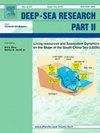Diapycnal oxygen flux in the oxycline region of the core of the Arabian Sea Oxygen Minimum Zone
IF 3
3区 地球科学
Q2 OCEANOGRAPHY
Deep-sea Research Part Ii-topical Studies in Oceanography
Pub Date : 2025-06-03
DOI:10.1016/j.dsr2.2025.105499
引用次数: 0
Abstract
This study quantified the relative contributions of double diffusion and shear-driven mixing on the diapycnal oxygen flux in the oxycline region of the core of the Arabian Sea Oxygen Minimum Zone (OMZ), a critical oceanic region regulating the local ecosystem dynamics significantly. For that purpose, we used concurrent measurements of vertical profiles of dissolved oxygen and microstructure shear collected during the scientific cruise in May 2019. It was found that the presence of a moderately strong salt finger regime in the oxycline region enhanced the downward diapycnal oxygen flux (-7.0 ± 0.5x10-2 μmol m-2 s-1) by an order of magnitude higher in contrast to traditionally considered shear-driven turbulence alone (-6.4 ± 0.7 x 10-3 μmol m-2 s-1). This difference is solely attributable to the small magnitude of diapycnal diffusivity due to shear-driven turbulence (2.8 ± 1.1 x 10-6 m2 s-1) compared to salt finger (10-5 to 10-4 m2 s-1). For the sake of comparison, the magnitude of lateral flux of oxygen due to horizontal circulation (3x10-4 μmol m-2 s-1) and oxygen consumption rates due to biological processes estimated from observation (-3x10-3 to -40 x 10-3 μmol m-2 s-1) were much smaller than salt finger induced downward diapycnal oxygen flux in the oxycline region. As a result, there was a net downward oxygen flux from the oxycline into the OMZ. These findings highlighted the need to incorporate double diffusion processes in biogeochemical models to improve the accuracy of vertical oxygen distribution simulations in the Arabian Sea OMZ.
阿拉伯海氧极小带核心的氧斜区底旋氧通量
本研究量化了双重扩散和剪切混合对阿拉伯海氧最小带(OMZ)核心氧斜区(一个显著调节当地生态系统动态的关键海洋区域)内氧环流通量的相对贡献。为此,我们同时测量了2019年5月科学巡航期间收集的溶解氧垂直剖面和微观结构剪切。研究发现,在氧斜区存在中等强度的盐指区,与传统上认为的剪切驱动湍流(-6.4±0.7 x 10-3 μmol m-2 s-1)相比,下向的氧通量(-7.0±0.5x10-2 μmol m-2 s-1)提高了一个数量级。这种差异完全是由于与盐指(10-5至10-4 m2 s-1)相比,由剪切驱动的湍流(2.8±1.1 x 10-6 m2 s-1)导致的内旋扩散率较小。相比之下,观测得到的水平环流侧向氧通量(3 × 10-4 μmol m-2 s-1)和生物过程耗氧速率(-3 × 10-3 ~ -40 × 10-3 μmol m-2 s-1)均远小于氧斜区盐指诱导的向下横向氧通量。结果,有一个净向下的氧通量从氧斜层进入OMZ。这些发现强调了在生物地球化学模型中纳入双重扩散过程的必要性,以提高阿拉伯海OMZ垂直氧气分布模拟的准确性。
本文章由计算机程序翻译,如有差异,请以英文原文为准。
求助全文
约1分钟内获得全文
求助全文
来源期刊
CiteScore
6.40
自引率
16.70%
发文量
115
审稿时长
3 months
期刊介绍:
Deep-Sea Research Part II: Topical Studies in Oceanography publishes topical issues from the many international and interdisciplinary projects which are undertaken in oceanography. Besides these special issues from projects, the journal publishes collections of papers presented at conferences. The special issues regularly have electronic annexes of non-text material (numerical data, images, images, video, etc.) which are published with the special issues in ScienceDirect. Deep-Sea Research Part II was split off as a separate journal devoted to topical issues in 1993. Its companion journal Deep-Sea Research Part I: Oceanographic Research Papers, publishes the regular research papers in this area.

 求助内容:
求助内容: 应助结果提醒方式:
应助结果提醒方式:


